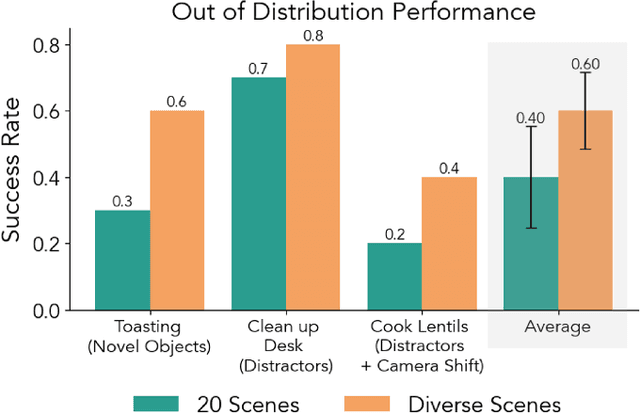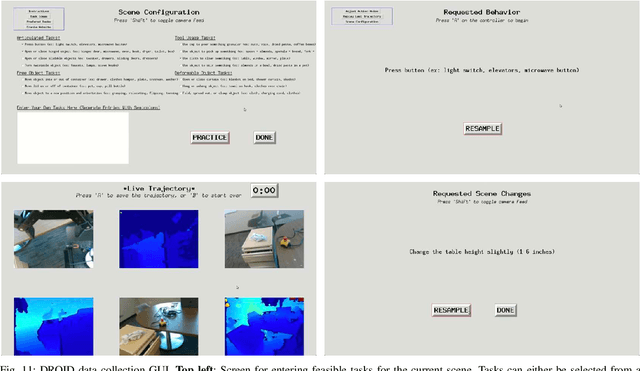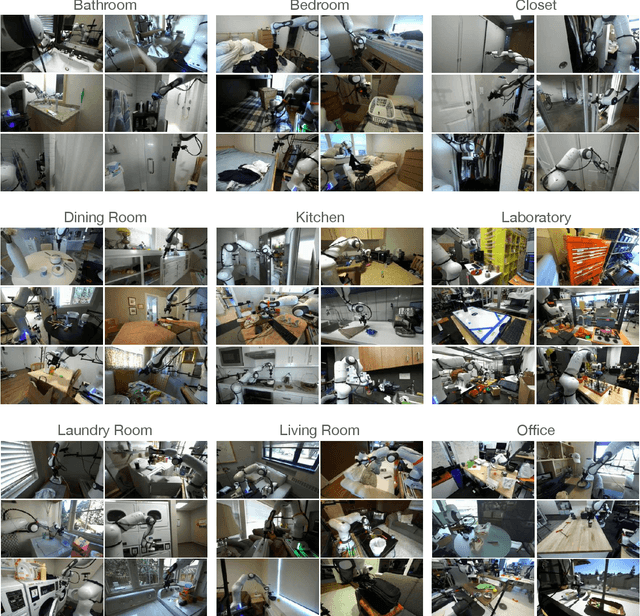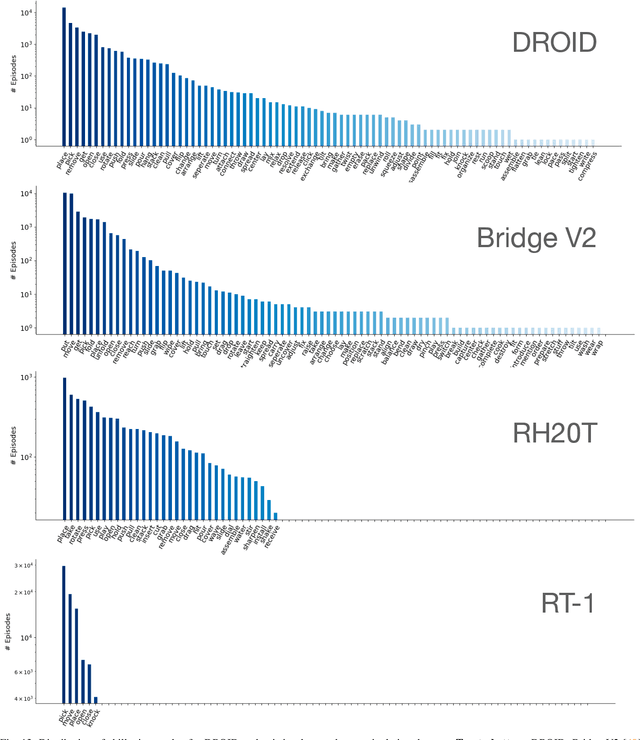Daniel Morton
Scan, Materialize, Simulate: A Generalizable Framework for Physically Grounded Robot Planning
May 20, 2025Abstract:Autonomous robots must reason about the physical consequences of their actions to operate effectively in unstructured, real-world environments. We present Scan, Materialize, Simulate (SMS), a unified framework that combines 3D Gaussian Splatting for accurate scene reconstruction, visual foundation models for semantic segmentation, vision-language models for material property inference, and physics simulation for reliable prediction of action outcomes. By integrating these components, SMS enables generalizable physical reasoning and object-centric planning without the need to re-learn foundational physical dynamics. We empirically validate SMS in a billiards-inspired manipulation task and a challenging quadrotor landing scenario, demonstrating robust performance on both simulated domain transfer and real-world experiments. Our results highlight the potential of bridging differentiable rendering for scene reconstruction, foundation models for semantic understanding, and physics-based simulation to achieve physically grounded robot planning across diverse settings.
Real-Time Out-of-Distribution Failure Prevention via Multi-Modal Reasoning
May 15, 2025Abstract:Foundation models can provide robust high-level reasoning on appropriate safety interventions in hazardous scenarios beyond a robot's training data, i.e. out-of-distribution (OOD) failures. However, due to the high inference latency of Large Vision and Language Models, current methods rely on manually defined intervention policies to enact fallbacks, thereby lacking the ability to plan generalizable, semantically safe motions. To overcome these challenges we present FORTRESS, a framework that generates and reasons about semantically safe fallback strategies in real time to prevent OOD failures. At a low frequency in nominal operations, FORTRESS uses multi-modal reasoners to identify goals and anticipate failure modes. When a runtime monitor triggers a fallback response, FORTRESS rapidly synthesizes plans to fallback goals while inferring and avoiding semantically unsafe regions in real time. By bridging open-world, multi-modal reasoning with dynamics-aware planning, we eliminate the need for hard-coded fallbacks and human safety interventions. FORTRESS outperforms on-the-fly prompting of slow reasoning models in safety classification accuracy on synthetic benchmarks and real-world ANYmal robot data, and further improves system safety and planning success in simulation and on quadrotor hardware for urban navigation.
Deformable Cargo Transport in Microgravity with Astrobee
May 02, 2025Abstract:We present pyastrobee: a simulation environment and control stack for Astrobee in Python, with an emphasis on cargo manipulation and transport tasks. We also demonstrate preliminary success from a sampling-based MPC controller, using reduced-order models of NASA's cargo transfer bag (CTB) to control a high-order deformable finite element model. Our code is open-source, fully documented, and available at https://danielpmorton.github.io/pyastrobee
Safe, Task-Consistent Manipulation with Operational Space Control Barrier Functions
Mar 09, 2025



Abstract:Safe real-time control of robotic manipulators in unstructured environments requires handling numerous safety constraints without compromising task performance. Traditional approaches, such as artificial potential fields (APFs), suffer from local minima, oscillations, and limited scalability, while model predictive control (MPC) can be computationally expensive. Control barrier functions (CBFs) offer a promising alternative due to their high level of robustness and low computational cost, but these safety filters must be carefully designed to avoid significant reductions in the overall performance of the manipulator. In this work, we introduce an Operational Space Control Barrier Function (OSCBF) framework that integrates safety constraints while preserving task-consistent behavior. Our approach scales to hundreds of simultaneous constraints while retaining real-time control rates, ensuring collision avoidance, singularity prevention, and workspace containment even in highly cluttered and dynamic settings. By explicitly accounting for the task hierarchy in the CBF objective, we prevent degraded performance across both joint-space and operational-space tasks, when at the limit of safety. Our open-source, high-performance software will be available at our project webpage, https://stanfordasl.github.io/oscbf/
DROID: A Large-Scale In-The-Wild Robot Manipulation Dataset
Mar 19, 2024



Abstract:The creation of large, diverse, high-quality robot manipulation datasets is an important stepping stone on the path toward more capable and robust robotic manipulation policies. However, creating such datasets is challenging: collecting robot manipulation data in diverse environments poses logistical and safety challenges and requires substantial investments in hardware and human labour. As a result, even the most general robot manipulation policies today are mostly trained on data collected in a small number of environments with limited scene and task diversity. In this work, we introduce DROID (Distributed Robot Interaction Dataset), a diverse robot manipulation dataset with 76k demonstration trajectories or 350 hours of interaction data, collected across 564 scenes and 84 tasks by 50 data collectors in North America, Asia, and Europe over the course of 12 months. We demonstrate that training with DROID leads to policies with higher performance and improved generalization ability. We open source the full dataset, policy learning code, and a detailed guide for reproducing our robot hardware setup.
Task-Driven Manipulation with Reconfigurable Parallel Robots
Mar 16, 2024



Abstract:ReachBot, a proposed robotic platform, employs extendable booms as limbs for mobility in challenging environments, such as martian caves. When attached to the environment, ReachBot acts as a parallel robot, with reconfiguration driven by the ability to detach and re-place the booms. This ability enables manipulation-focused scientific objectives: for instance, through operating tools, or handling and transporting samples. To achieve these capabilities, we develop a two-part solution, optimizing for robustness against task uncertainty and stochastic failure modes. First, we present a mixed-integer stance planner to determine the positioning of ReachBot's booms to maximize the task wrench space about the nominal point(s). Second, we present a convex tension planner to determine boom tensions for the desired task wrenches, accounting for the probabilistic nature of microspine grasping. We demonstrate improvements in key robustness metrics from the field of dexterous manipulation, and show a large increase in the volume of the manipulation workspace. Finally, we employ Monte-Carlo simulation to validate the robustness of these methods, demonstrating good performance across a range of randomized tasks and environments, and generalization to cable-driven morphologies. We make our code available at our project webpage, https://stanfordasl.github.io/reachbot_manipulation/
Autonomous Material Composite Morphing Wing
Jan 19, 2023



Abstract:Aeronautics research has continually sought to achieve the adaptability and morphing performance of avian wings, but in practice, wings of all scales continue to use the same hinged control-surface embodiment. Recent research into compliant and bio-inspired mechanisms for morphing wings and control surfaces has indicated promising results, though often these are mechanically complex, or limited in the number of degrees-of-freedom (DOF) they can control. Seeking to improve on these limitations, we apply a new paradigm denoted Autonomous Material Composites to the design of avian-scale morphing wings. With this methodology, we reduce the need for complex actuation and mechanisms, and allow for three-dimensional placement of stretchable fiber optic strain gauges (Optical Lace) throughout the metamaterial structure. This structure centers around elastomeric conformal lattices, and by applying functionally-graded warping and thickening to this lattice, we allow for local tailoring of the compliance properties to fit the desired morphing. As a result, the wing achieves high-deformation morphing in three DOF: twist, camber, and extension/compression, with these morphed shapes effectively modifying the aerodynamic performance of the wing, as demonstrated in low-Reynolds wind tunnel testing. Our sensors also successfully demonstrate differentiable trends across all degrees of morphing, enabling the future state estimation and control of this wing.
 Add to Chrome
Add to Chrome Add to Firefox
Add to Firefox Add to Edge
Add to Edge